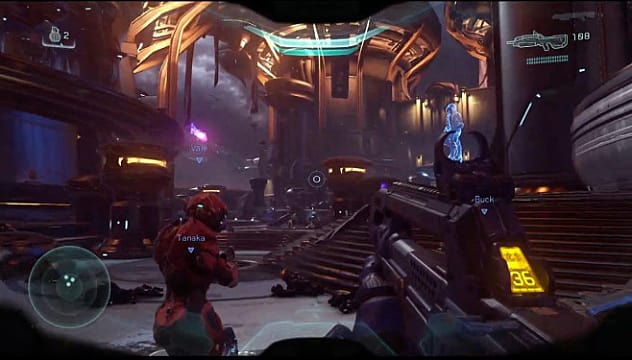The initial Xbox One reveal went over atrociously with fans, and save for Sunset Overdrive, the early exclusives did little to impress. For this year’s E3 though, Microsoft has substantially upped their game.
Halo 5: Guardians is looking to significantly push its franchise forward with its new four-player campaign mode and massive Warzone mode. Nothing of this scale has been attempted by first-person shooters in years, the closest being Killzone 3’s Operations mode nearly half a decade ago. The chaotic mix of AI controlled Covenant enemies and two opposing player teams opens up the potential for some of the most dynamic battles in the series history.
Backwards compatibility with Xbox 360 games (both digital and physical copies) is also a major windfall.
The PlayStation 4 literally is not capable of doing the same with PlayStation 3 games due to hardware constraints, so now Microsoft can get additional converts holding onto their older consoles.
While the update will be coming later this year, it still means that there is a far higher chance that people will be making the jump. The inclusion of online multiplayer support, and the ability to play with Xbox 360 users. The idea of a connected Xbox that the original pitch for the Xbox One focused on survives, and it brings on legacy hardware to last far longer. To help further emphasize how great this could be for Xbox One, Rainbow Six: Siege is even including the past two Rainbow Six: Vegas games to sweeten the pot.
This all goes along with previous reveals that Xbox One would not only support its own version of Windows 10, in order to be used as a PC, but will have cross-platform support with Windows 10. Instead of using this for a singular game, as they did with Windows Vista and Xbox 360 years back, we are seeing several major multiplayer games going cross-platform – with Gigantic and Fable Legends leading the charge.
Another tie-in to this will be the upcoming Xbox One update that will add dev kit functionality to all Xbox One consoles. Already, thousands of indie devs have ported their games to Xbox One first, if not exclusively to the console and PC. The chance there for more cross-platform experiences alone is quite exciting.
Further blurring the lines between PC and console is the move for Xbox One to support mods.
Fallout 4 will reportedly support all Creation Kit mods made for the PC version on Xbox One as well. This includes total conversions, meaning that for the first time since Unreal Tournament 3 on PlayStation 3, we can see massive mods brought to console.
There will also be an integrated user-generated content creation toolset built into DOOM for all players, both on consoles and PC. So two of the biggest upcoming games are now going to push for open mod support, and Microsoft is helping lead that charge. This goes great with their already existent efforts with Forge mode in Halo: The Master Chief Collection and Halo 5: Guardians, and Project Spark’s “build your own games” core concept.
This is particularly a surprising turn of events as, during the PlayStation 3’s lifespan, Sony tried to push for user-generated content, but has all but dropped that as a major focus with their most recent games.
Killzone: Shadow Fall and Little Big Planet 3 might offer some user-generated content, but they still don’t compare to Project Spark and Forge mode, and the inFamous series has completely abandoned the user generated missions of inFamous 2. Perhaps Microsoft’s new initiative will spur Sony to reconsider moving back to its original stance on user-generated content.
In fact, a lot of what Microsoft has done with the Xbox One could be seen as taking notes from past Sony ideas.
The PlayStation 2 and 3 both supported Linux as a second OS, now Xbox One has Windows 10. The PlayStation 3 encourages user-generated content, and so now does the Xbox One. As Sony has happily stood up with the PlayStation 4 as the grand next step in gaming, all their old and abandoned ideas seem to be coming back to haunt them.
Another great step is the new controller, the Xbox One Elite.
Rather than simply make a new version of the controller with a headset adapter, the new controller has one of the most distinctively customizable designs ever. For example, there are controller inputs on the bottom if you prefer to grip from below, enabling slightly faster reflexes in action games.
Except, if you don’t want those, you can just take them off and play with the normal front triggers. Also, if you want a more thumb-friendly gamepad, you can try the new blocked out pad that is styled after the Steam Controller. Or you can use the traditional gamepad. You can even swap the sticks to the original ones for the first controller.
The Xbox One’s new controller may be the most flexible, user-friendly controller out there.
Short of letting you swap the sticks and D-pad around, there is little more you could ask from it. This bodes well for both Windows and Xbox gamers, as it is compatibility with both operating systems like the original Xbox One controller. It’s easy to say today is a good day to be a gamer playing on Microsoft systems.
We’ll have to wait and see what Sony has up their sleeve, but for the first two in two years, Microsoft is a worthwhile opponent. It took a lot of reworking and getting at what their audience wanted, but it seems like Xbox is finally on the right track again.
Your move, Sony.


